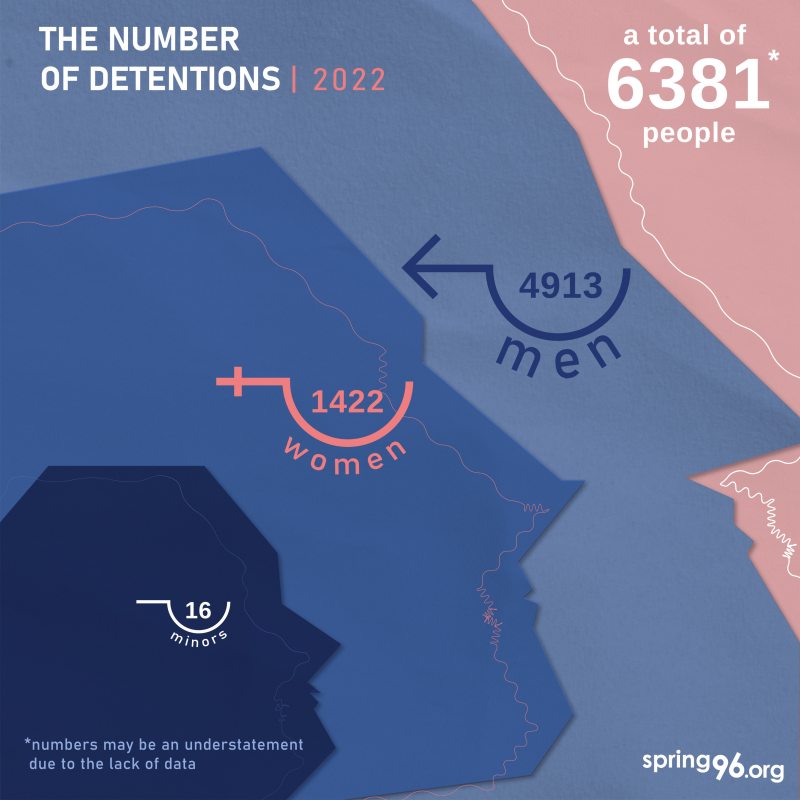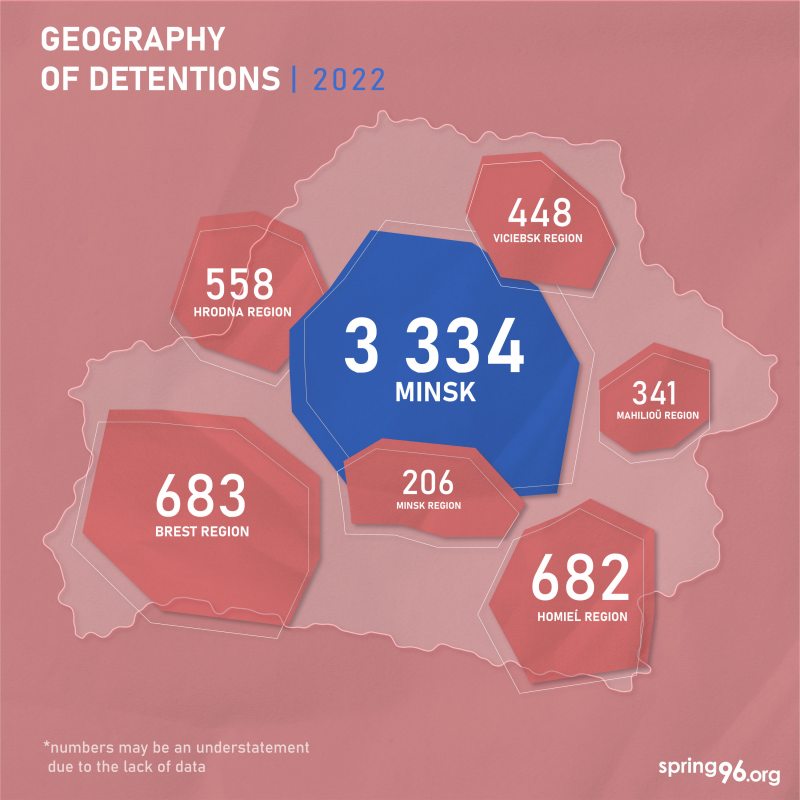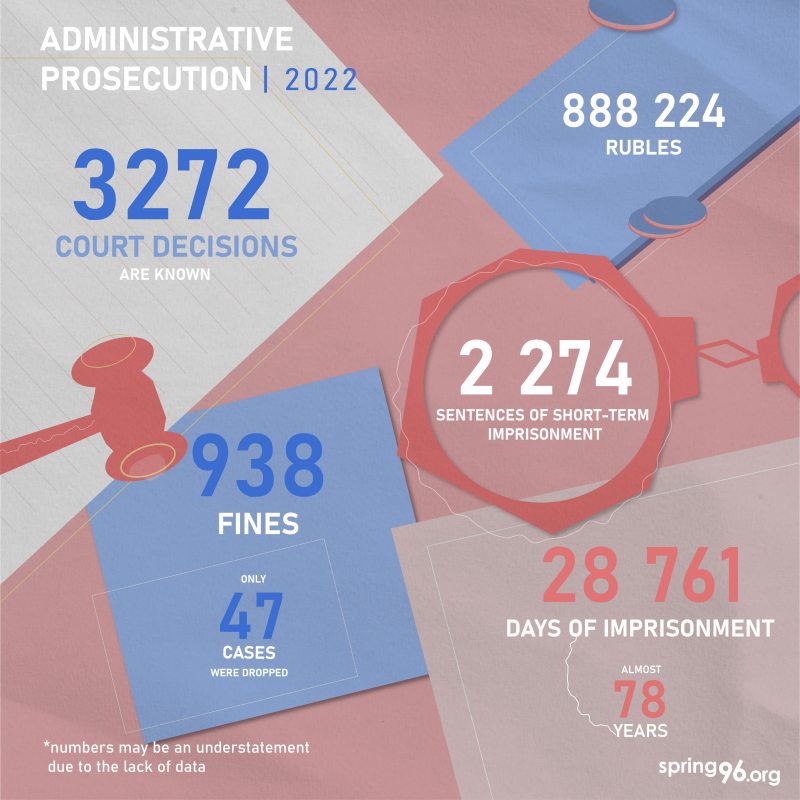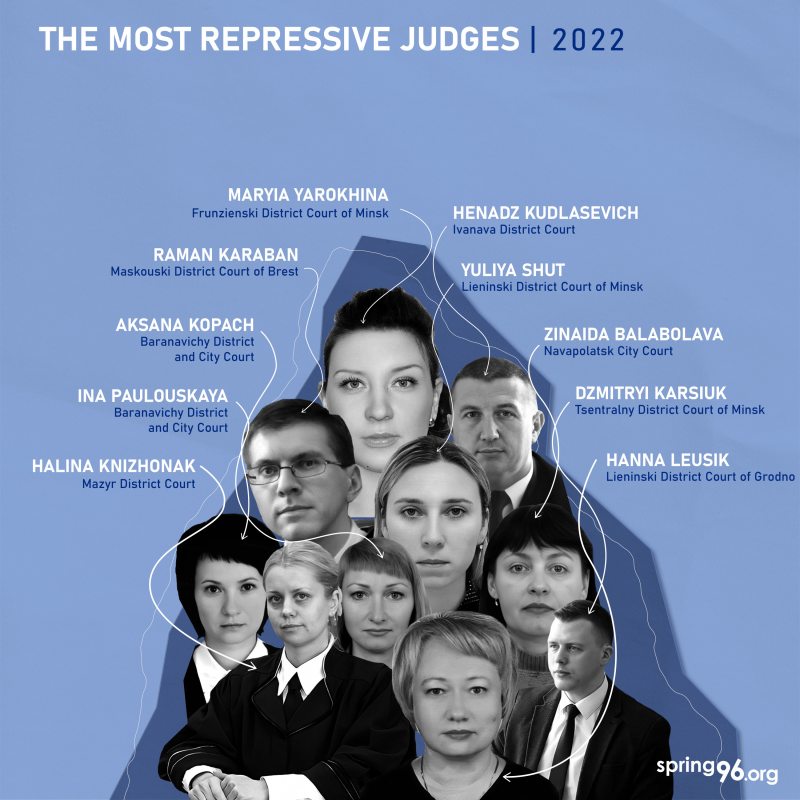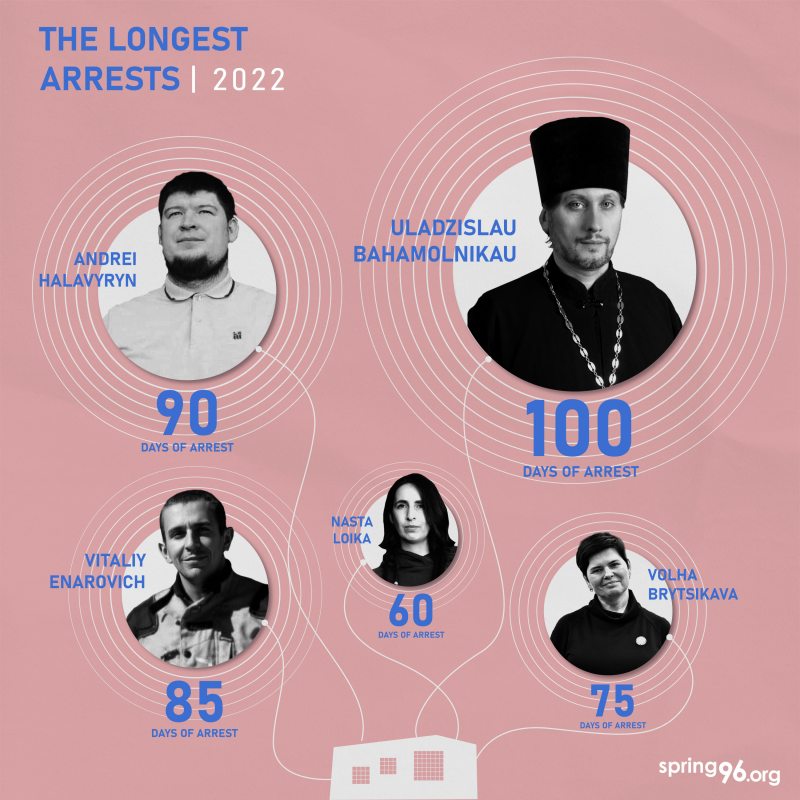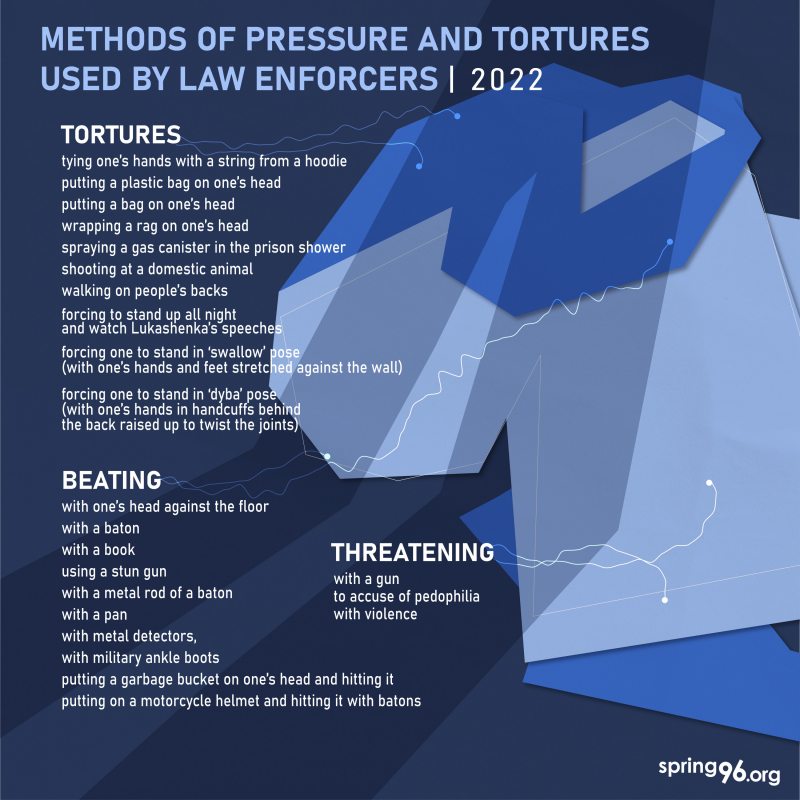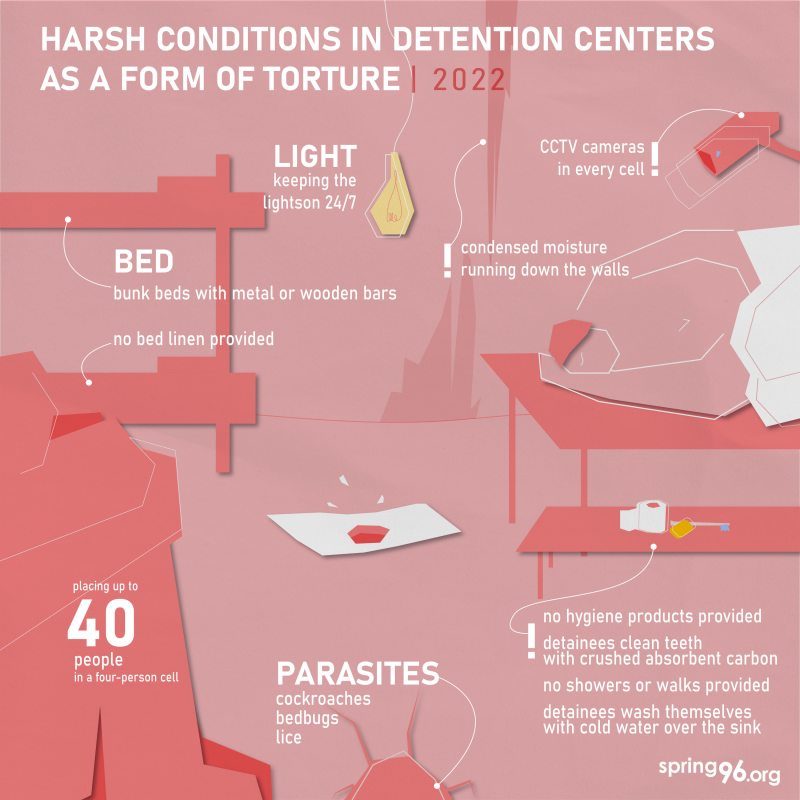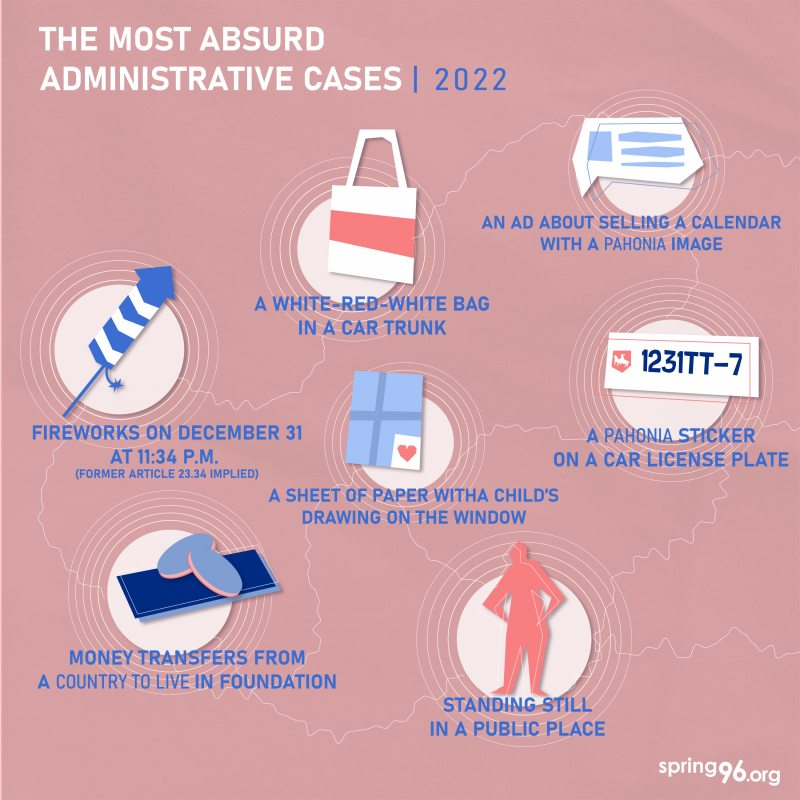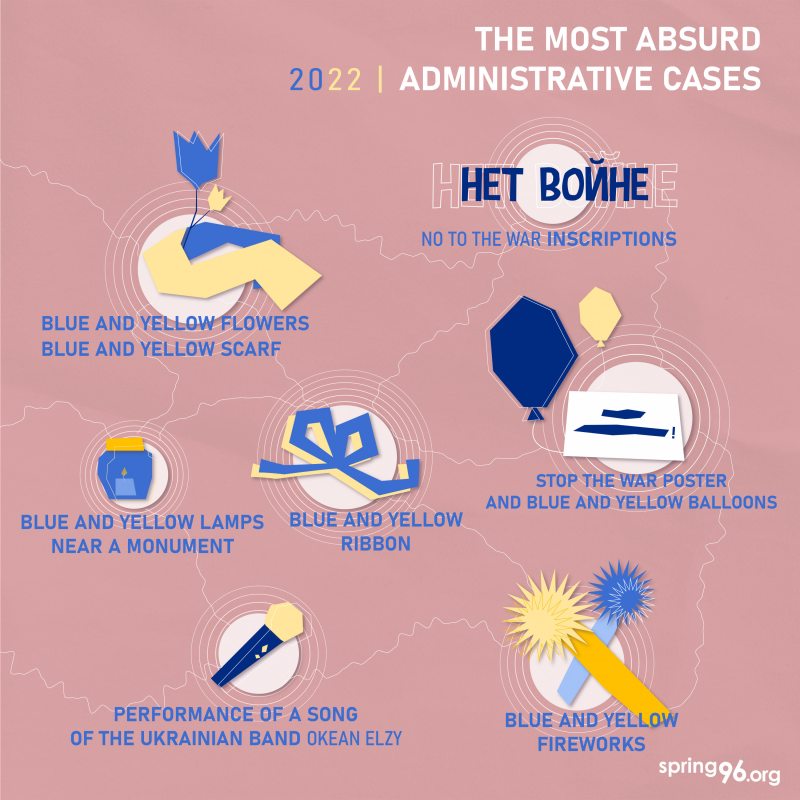Administrative prosecution in 2022: At least 6,380 arrests
For almost two and a half years repression has been going on in Belarus. The human rights situation in the country is deteriorating every day. Last year, it got to the point where firearms were used to arrest “rail guerrillas” and some detainees’ pets were shot. Since Russia's invasion of Ukraine, the authorities have been actively prosecuting Belarusians for anti-war protests. A total of at least 6,381 people were arrested in 2022, according to human rights activists. This makes a minimum of 17 people a day. Read our yearly review of administrative persecution.
The number of arrests for the past year
Activists of the Human rights center Viasna know about 6,379 people who were detained last year. Of them, almost 1,500 are women, and another 5,000 are men. It is also known that at least 15 minors were detained.
Geography of arrests
Most of the arrests took place in Minsk, where 3,334 people were detained. Brest and Homieĺ regions are next in the number of detainees with 683 and 682 detainees respectively. It is in these regions that the police actively pursue locals for protesting against the war in Ukraine and for taking pictures of Russian military equipment.
Administrative prosecution in 2022
Viasna has information about at least 3,272 court decisions. Belarusian courts imposed at least 938 fines totaling 888,224 Belarusian rubles (approx. $325,000). Judges also ordered at least 2,274 short-term jail sentences. In total, Belarusians spent 28,804 days in detention centers (almost 78 years). At the same time, only 47 cases were dropped for various reasons, according to human rights defenders.
The most active judges
Naturally, most of the trials take place in Minsk. However “kangaroo courts” are operating all over the country. In 2022, mass raids were carried out in different cities in Belarus, after which local judges sentenced residents to huge fines and arrests. That is why our list of the most repressive judges includes not only Minsk judges but also judges from the regions.
So, for example, Navapolack judge Zinaida Balabolava is known for her harsh decisions against the head of the Naftan independent trade union Volha Brytsikava, activists Hanna Tukava and Andrei Halavyryn, and state-owned oil refinery Naftan employees.
Judge of the Ivanava Region Henadz Kudlasevich tried local residents arrested in a police crackdown on protesters. During one of the trials, he became indignant and yelled at a defendant, as he did not understand why she did not open the gate to unknown men in black clothes.
For several months, a wave of repression continued in Baranavičy. Police summoned local residents for “preventive conversations”, forced them to take polygraphs and submit biomaterials, summoned people for interrogations, and arrested them for “dissemination of extremist materials”. Judges Aksana Kapach and Ina Paulouskaya, sentenced dozens of people to short-term imprisonment and huge fines.
Mazyr district judge Halina Knizhonak, who is known for her harsh sentences in criminal trials, also often considers administrative "political" cases. So, for example, in November, she sentenced to a jail term the political prisoner Hleb Koipish, who is now serving a term in an open-type penal facility. Then, he was found guilty of “disseminating extremist materials” under Article 19.11 of the Code of Administrative Offenses.
Judge Raman Karaban works in the Maskoŭski District Court of Brest. He tried locals for sharing posts from “extremist channels” and for “picketing” by displaying a white-red-white sticker on a car.
In Hrodna, one of the active “political” judges is Hanna Leusik. In February of last year, she fined Tatsiana Sauko, a local resident, 800 rubles (approx. US$315) for “disseminating extremist materials”. There were a lot of mistakes in the case materials, but the judge paid no attention to it.
In Minsk, Dzmitryi Karsiuk is one of the most “repressive” judges. In February 2022, he sentenced the fifth-year student of the Belarusian National Technical University Mikalai Antanevich for photographing a woman with a Stop the War poster and air balloons in blue and yellow colors. Judge Karsiuk found the student guilty under Article 24.3 of the Code of Administrative Offenses (disobedience to police officers) and sent him to jail for 15 days.
The judge of the Lieninski district of Minsk Yuliya Shut often presides over trials for “political” offences. She also tried people for participation in anti-war rallies on February 27.
Judge Maryia Yarokhina is known for ignoring the statements of beatings and torture in detention and saying that these are irrelevant. She often sent Belarusians to jail and fines them for sharing “wrong” posts and “petty hooliganism”.
The longest jail terms for administrative offences in 2022
For two years, the authorities have been actively using re-detentions to put additional pressure on detainees. Former prisoners call it a “merry-go-round”: a person is not released after a short-term imprisonment but is re-detained under another police report. In this way, people can be kept behind bars for several months, without hygiene products and underwear. Last year, human rights activists became aware of four of the most egregious such cases.
Uladzislau Bahamolnikau—100 days in jail
Bahamolnikau is an Orthodox priest and a lecturer at the Minsk Theological Academy. In 2020, he held a service for Raman Bandarenka who died after reportedly being beaten by security forces. Bahamolnikau also went on hunger strike in support of the political prisoner Ihar Losik. The priest was detained by officers of the Main Directorate for Combating Organized Crime and Corruption (GUBOPiK) on August 31. He spent 100 days of administrative imprisonment under seven reports. Each time he was tried for forwarding messages from “extremist” channels in private correspondence. It is known that while in prison Bahamolnikau went on hunger strike and had Covid-19.
Volha Brytsikava—75 days in jail
The head of the independent trade union at the state-owned oil refinery Naftan Volha Brytsikava was detained for the first time on February 27. After that, the police filed five reports against her under “people's” articles. Judge Zinaida Balabolava sentenced her to 15 days of administrative imprisonment under each. After 75 days, Brytsikava was released, but she was detained again in early November. She was sentenced twice in a row to 15 days of imprisonment. Brytsikava went on a hunger strike for several days in protest of violation of her rights and the refusal of the jail officers to hand over care packages from her relatives to her.
In total, Volha Brytsikava spent 105 days behind bars in 2022.
Andrei Halavyryn—90 days in jail
On June 15, the Navapolack activist Andrei Halavyryn was arrested and placed in the local center for isolation of offenders. He was tried six times for being subscribedto “extremist” channels and forwarding their posts under Article 19.11 of the Code of Administrative Offenses. Judge Balabolava ordered to place the activist in jail for 15 days in all of the trials. During his first jail time, the man suffered a hypertensive crisis.
Vital Yenarovich—85 days in jail
Vital Yenarovich from Minsk was detained around the middle of March and stayed in custody for 85 days. It is known that the last trial for the administrative offence took place on May 31 in the Maskoŭski District Court of Minsk. The case was considered by judge Siarhei Katser. The man has been later charged with two criminal offences: incitement of social hatred (part 1 of Article 130 of the CC) and active participation in actions that grossly violate public order (part 1 of Article 342 of the CC)
Nasta Loika—60 days in jail
Human rights defender Nasta Loika was detained on October 28, 2022. Prior to that, she had already served 30 days of administrative imprisonment. After her arrest, a “confession video” appeared, where Nasta “admits” that she had received funding from foreign organizations. After her arrest, she was convicted four times in a row for “petty hooliganism” under Article 19.1 of the Code of Administrative Offenses. At one of the trials, the human rights activist spoke about torture: one of the officers hit her with a taser, and another one took her out into the courtyard where she stayed without clothes for eight hours.
At the end of December, the political prisoner was charged under two articles—one of them is known to be Article 342 of the Criminal Code.
What methods of pressure and torture were used by security forces in 2022
Throughout 2022, human rights defenders documented facts of torture and inhuman treatment. Viasna is aware of cases when Belarusians were beaten with truncheons, a frying pan, a stun gun, a metal detector, and combat boots during their arrest. Some people were put trash bins or motorcycle helmets on their heads and beaten with truncheons. Stun guns are often used in order to force detainees to testify. After the mass arrests for participation in the anti-war rally, people were not only beaten during arrests, but also tortured in the infamous the detention facility on Akrescina street in Minsk. Officers sprayed gas into the shower vents, walked on people and stomped on their backs; detainees were taken out into the corridor and beaten.
It is known that last year the security forces actively used firearms. They shot to kill the “rail guerrillas” and tried to shoot the dogs of the detainees.
The most notorious case of the use of weapons by law enforcers in 2022 is the detention of “rail guerrillas”. On the night of March 30, three “guerillas” from Babrujsk were arrested with the support by a SWAT squad. The Ministry of Internal Affairs reported then that “during the arrest the men showed active resistance and tried to escape”. The security forces were shooting to kill. One of the detainees was injured and delivered to hospital, while the rest received medical treatment on the spot. The photo published by the Ministry of Internal Affairs probably shows Uladzimir Auramtsau.
In the same shooting, Vital Melnik was shot in the knee. On December 22, he was sentenced to 16 years imprisonment in a maximum-security penal colony. He is still using crutches.
An IT specialist Aliaksei Kavaleuski has also told about the interrogation with pistols in the forest in the spring. He tried to leave the country but was detained by the KGB right on the road. First, he had been severely beaten, and then he and his driver had been taken to the forest in the trunk, where officers had used stun guns to torture them, Kavaleuski says. In the woods, the plainclothes officers interrogated him. As it turned out, some “rail guerillas” from Babrujsk were supposed to be in the same car. It was a special operation to catch a person who helps with border crossing.
In Ivanava, Brest region, on June 14, 2022, the police raided local residents. On that day, Alena Putsykovich was detained, and in her yard, security forces shot a dog with a rubber bullet, severely injuring the animal.
One of the employees of GUBOPiK in plain clothes, a helmet, a bulletproof vest and with a riffle held the dog at gunpoint until Alena came out. He demanded the animal be taken away. Not a minute later, the man had already shot the dog. The woman's 15-year-old daughter was at home. Accompanied by the law enforcement officer, she carried the injured dog to the cage.
Also, in early September, a family was detained in Minsk: two brothers, Ales and Yan Papkovich, and Yan's wife, Anastasiya Papkovich. They hadn't even had time to get dressed after sleeping when two law enforcers in full gear with machine guns and four men in black uniforms broke into the room, according to Anastasiya. Apart from her and Yan, their pit bull was sleeping in the room and started barking at strangers. One of the law enforcers, according to the girl, shot the dog twice with a machine gun, the woman says. The first bullet went tangentially and wounded the dog in the muzzle. The second bullet came close to the dog and Yan.
Appalling detention conditions as a form of torture
Since the crackdown on peaceful protest against rigged presidential elections in August 2020, inhumane detention conditions without hygiene products or a change of clothes became a norm. Some people are staying in custody for up to three months and can breathe fresh air only on the way to the police department, where a new protocol will be drawn up against them.
“Political” prisoners are kept separately in overcrowded cells. People have to sleep on the floor, under beds, and on benches. They are not given bed linen and are not allowed to shower or take a walk. Homeless people with poor hygiene are put in the same cells for additional pressure. The light are always on, even at night.
Soap and toilet paper were handed over only upon special request to administration and in some cases one had to wait for two or three days for the request to be fulfilled.
Detainees are constantly monitored through security peephole and video surveillance in the cells. There is no warm water, and tap water is not safe to drink.
Those who are taken away from home are not even allowed to take hygiene products, so people come up with new ways, such as brushing their teeth with the things that are in the cell. Care packages from families do not reach people.
Medical aid is not provided, despite the fact that many people arrive badly beaten. The only source of information is the newly coming cellmates. These conditions are considered by human rights activists as torture.
The most absurd accusations in 2022
As before, white-and-red allusions to “protest” flag, Long live Belarus! slogan, and blank sheets of paper are regarded as anti-government protest and could lead to arrest. The Ministry of Internal Affairs even updated the Nazi symbols list with “shouting Long live Belarus while raising the right hand with a straightened palm”.
Since the first day of the war in Ukraine, people of Belarus have been expressing their disagreement with Russian aggression in which Belarus is used as a launchpad. At least 2,000 people were detained for anti-war protests across the country. Most of them are prosecuted in administrative cases, and some are subjected to criminal proceedings.
But despite the consequences, Belarusians still continue to hold peaceful protests. Viasna compiled a list of the strangest and most ridiculous reasons why Belarusians were tried in 2022.
Setting off New Year's fireworks at the “wrong” time
In early January 2022, a husband and wife were tried in Minsk for setting off the fireworks on December 31 at 11:34 pm, or 23:34 in 24-hour format. The number has a hidden meaning referring to the infamous “people’s” article 23.34 used to persecute protesters. Alena Hayeuskaya and her husband Mikalai Hayeuski were arrested immediately after they had started the fireworks on December 31. Officers of the Partyzanski district police department drew up reports under Article 24.23 of the Code of Administrative Offenses (former Article 23.24) for "unauthorized picketing". The couple did not admitted their guilt at court.
Judge Makarevich concluded that the time of the set-off, fireworks colors, and the slogans in a public place indicate the political nature of the actions. She sent Mikalai in jail for 15 days, and Alena—for 13 days.
Receiving money from the A Country to Live in foundation
At the end of June, KGB officers detained a married couple in Minsk. After interrogation, they were released, but a report was filed against the husband under Part 6 of Article 24.23 of the Code of Administrative Offenses for “violation of the procedure for organizing or holding mass events, which is accompanied by the payment of a reward for participation in a mass event”.
The man received 900 euros from the A Country to Live in foundation, which he used to pay his wife's fines for participating in protests.
It is known that the woman was detained twice in 2020.
The trial over the man was held on July 4. At the process, he pleaded guilty in full. Judge of the Maskoŭski District Court of Minsk Tatsiana Matyl found the man guilty under part 7 of Article 24.23 of the Code of Administrative Offenses, with the article having only six parts. The defendant was fined 480 rubles (approx US$190). In addition, the court ruled to seize the value of the "object of administrative offense" to the state—2,396 rubles and 7 kopecks, which is an equivalent of 900 euros.
Writing Long live Belarus on a snow-covered car
The Čyhunačny District Court of Viciebsk passed a verdict in administrative proceedings against a local resident: the man was sentenced to 10 days in jail for writing Long live Belarus on the snow-covered car of his neighbor, a police officer. The judge considered it unauthorized picketing.
At the court, the man said that he just wanted to cheer up his neighbor.
“Picketing” with a bag in white and red in the trunk
In Vaŭkavysk, a woman was sentenced under part 3 of Article 24.23 of the Code of Administrative Offenses for “unauthorized picketing” at the beginning of August. She was accused of “placing a bag of white-red-white color in the trunk of her car for public display, and placing symbols with the ornament of same colors on the car panel”. The woman did not admit her guilt. As a result, the court decided to fine her 4,960 Belarusian rubles (approx. $2,000) and seize her car and phone until she pays the fine.
The woman appealed the court's decision. On September 15, the appeal was considered by the Hrodna Regional Court. The woman stated that white-red-white things in her car were not of an anti-government protest nature. She also said in court that her constitutional rights had been violated, and she was prosecuted illegally. However, the decision was left unchanged and the appeal was dismissed.
Placing the Pahonia emblem on the car license plate
Dzmitryi Kavalenka was sentenced to 15 days in jail on September 29 in Minsk after police officers spotted a small Pahonia emblem on the license plate of his car. He was found guilty of “holding a picket with an ornamented license plate frame” (Article 24.23 of the Code of Administrative Offenses). In addition, Kavalenka’s car was taken away for examination and never returned to him.
Displaying child's drawing in the window
Yelisei Karpanau, 33, received 15 days in jail under Article 24.23 of the Code of Administrative Offenses for "unauthorized picketing". He was arrested on October 15, and tried two days later in the Maskoŭski District Court of Minsk. Karpanau took part in an unauthorized picketing by placing a blank sheet of paper on the window of his apartment, the police report states.
The man explained in court that there is a kid’s drawing on the other side—and it is the drawing that he posted on window. He disagreed that these actions are picketing. He also confirmed that he knew about such a method of protest. Judge Tatsiana Motyl found him guilty and sent to jail for 15 days.
Posting an ad for the sale of a calendar with Pahonia emblem on a marketplace
At the beginning of November, a “concerned citizen” filed a complaint against a man who had posted an advertisement for a calendar with a Pahonia emblem and Long live Belarus motto “to publicly express his social and political interests”. The police considered it as"unauthorized picketing" and wrote up a report under Article 24.23 of the Code of Administrative Offenses.
The man explained in court that he had posted the ad in early October and did not think it was an offence. He had no intention of picketing in this way. The Lieninski District court of Minsk sentenced the man to 15 days of administrative imprisonment.
Staying at same place in public without moving
On February 27, a group of six people who came from Kalinkavičy were arrested in Mazyr. An anti-war action was announced to start all over the country at 17:00. People were detained on the initiative of Mazyr district police officer, according to Viasna Paliessie branch. The officer reported that “three women and three men, in front of other passing by citizens, stayed in one place for a long time without moving, thus publicly demonstrating their mass gathering”.
As a result, they were all charged under Article 24.23 of the Code of Administrative Offenses for “staying in one place without moving in public”. They were tried in different courts: in Mazyr and Kalinkavičy.
It is known that the three women were fined 70 and 15 base fines (2240 and 480 rubles, respectively), the man was fined 800 rubles.
Holding Stop the War poster
Zhanna Trafimets from Minsk went to Kastryčnickaja Square in Minsk on March 1 with a one-person picket against Russia's attack on Ukraine. She held a Stop the War poster and yellow and blue balloons. The security forces detained her right along with her granddaughter. Officers of the Centraĺny district police department drew up a report for violation of Article 24.23 of the Code of Administrative Offenses for unauthorized picketing and served a summons to appear in court. A day later the judge of Centraĺny district court of Minsk Tatsiana Akavitaya fined the woman 95 basic units (3,040 rubles).
A fifth-year student of the Belarusian National Technical University Mikalai Antanevich, who was just taking photos of Zhanna, was also arrested along with the woman. He was sentenced to 15 days in jail.
Burning blue and yellow flares to celebrate Ukraine’s Independence Day
On November 3, a local woman was tried in the Lida District Court. She was accused of “unauthorized picketing” under Article 24.23 of the Code of Administrative Offenses. The woman posted on her Instagram a video of her celebrating the Independence day of Ukraine by burning flares in Ukraine national colors. The police considered it as a solitary picketing.
The woman did not deny her guilt at the court, but noted that she did not know that her performance was illegal.
As a result, the court found her guilty and fined 640 Belarusian rubles (approx. US$250).
Placing blue and yellow lamps at the monument to the victims of repressions
Viachaslau Bukas was detained in Babrujsk on September 9. The reason for the detention were two blue and two yellow lamps, which the man lit and placed near the monument “To Babruisk residents, victims of groundless repressions”. Thus, the man “was expressing his public and political opinion on the Independence Day of Ukraine", states the police report under Article 24.23 Code of Administrative Offenses for “unauthorized picketing”. Bukas admitted his guilt.
It is known that the police conducted a fingerprint examination to establish Bukas’ involvement in the “offence”. On September 12, Judge Alena Hormash found the man guilty and sentenced him to 15 days in jail.
Performing a Ukrainian rock song
On August 3, at one of the local outdoor bars, a singer Meryem Herasimenka performed a song by the Ukrainian rock band Okean Elzy. She was arrested and twice sentenced to 15 days of administrative imprisonment. Afterwards, Herasimenka was re-detained in a criminal case on group actions grossly violating public order (Article 342 of the Criminal Code).
Wearing a blue-and-yellow scarf
Siarhei Khlebadar, 54, was detained at a polling station on February 27 in Polack. The cause was a blue-and-yellow scarf he wore. According to the officers, the man thus took part in an “unauthorized picket”. The court found Khlebadar guilty under Article 24.23 of the Code of Administrative Offenses and sentenced him for 15 days of administrative imprisonment.
Holding blue and yellow flowers
On February 27, Katsiaryna Bekan was detained in the main square of Viciebsk for carrying blue and yellow flowers. The local police officers considered this to be "unauthorized picketing" and filed a report under Article 24.23 of the Code of Administrative Offenses. As a result he was sentenced to 10 days of administrative imprisonment under Article 24.23 of the Administrative Code.



